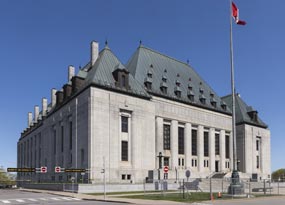Adam Chamberlain has a piece of advice for anyone even thinking of developing an energy project that touches on Aboriginal lands: get yourself into a canoe.
One of the most common mistakes project developers and their advisers make is to do too much of the work by email, conference calls and even video conferencing, says Chamberlain, national leader of the Team North, Aboriginal law and climate change groups at Borden Ladner Gervais LLP.
“The kind of advice I give people regularly is to spend the time, get to know people. One of the things that’s hardest is that when people fly up North – whether it’s somebody from a Bay Street law firm or accounting firm or business – they often fly into town and fly out,” says Chamberlain, who’s based in Toronto.
“The people in the North are accustomed to seeing what are generally white men come from the south to talk about things, then go home. That’s something that’s really important to try and overcome. Sharing dinner, or drinks, or breakfast or time around meetings together is often the most effective way to get to know people and understand them and their interests.”
Understanding – and aligning with – Aboriginal interests on energy development has become an issue that companies and their advisers downplay at their peril.
It used to be that the dealing with Aboriginal groups was mainly a matter of the Crown’s duty of consultation and accommodation. But the goalposts shifted dramatically with a Supreme Court of Canada decision called Tsilhqot’in (chill-KO-tin).
In the landmark ruling, the justices recognized the Tsilhqot’in Nation, six small semi-nomadic bands in BC, has title over a large swathe of land in the centre of the province. It was the first time Aboriginal title has ever been recognized by the court.
The decision gives the Tsilhqot’in, and any other group whose title claim is recognized from here on in, the exclusive right to decide how their land is used absent an overriding public interest.
It’s a right many in business say amounts to consent.
Where title is being asserted but the courts have not yet ruled – and there are over 100 such claims outstanding – Chief Justice Beverley McLachlin, writing for the court, said project developers can avoid problems by treating Aboriginal groups as if they already have that consent right. If they don’t, she cautioned, and title is later recognized, lawfully awarded permits could be cancelled, which means projects could even be shut down.
In the 14 months or so since it was handed down, Tsilhqot’in has had a discernable impact on First Nations, who have been arriving at the bargaining table with raised expectations, several practitioners agree.
“For many Aboriginal communities, there’s been a real boost of confidence in terms of their position,” says Maxime Faille, an Aboriginal law practitioner at Gowling Lafleur Henderson LLP in Ottawa. “I think it’s given a lot of them a little bit more swagger than they had before.
“In some cases, it’s catapulted groups into a position where they see this as a major tool, and opportunity for real leverage. They see the courts are there as a recourse if negotiations don’t pan out.”
That is creating some challenges for project developers, says Chamberlain.
“It can be a bit tricky because you raise people’s expectations, they come to the negotiating table, and they may or may not get what they want or think they are entitled to. From my point of view, the thing Tsilhqot’in is doing is it’s creating a potentially challenging environment for negotiating at times. There’s a whole pile of stuff simmering.”
What’s simmering are Aboriginal groups who signed away their rights in historic treaties with the federal government 150 years ago.
Many are simmering with anger.
Faille says many such groups are watching in some dismay as their brethren who never signed treaties or who signed modern-day treaties get far more say over development on their land.
“What we’re seeing is that people in those communities don’t accept they should be second- or even third-class citizens within the wider Aboriginal community in Canada. They’re saying they shouldn’t be punished, in effect, or disadvantaged for having come to terms with Canada 150 years ago when the country was forming and coming together.
“So there’s a strong sense that they should not be in a significantly worse position than those communities that didn’t sign a treaty, or that weren’t given that opportunity to enter into a treaty. It’s a serious issue.”
That apparent reversal of fortune, says Chamberlain, “is something I think is not only going to inflame the situation a bit but it’s also going to take those raised expectations and it’s going to make people say: ‘Wait a second. If they’ve got that, if they’ve got title and the ability to negotiate that, what should we be able to do here?’
“That is a challenge, and it’s something that over time is going to have to be resolved.”
There are strong indications the potentially explosive issue is headed for the courts.
Some First Nations are arguing the historic treaties under which they surrendered their land were actually just peace treaties, says Radha Curpen, co-head of the Aboriginal law group at Bennett Jones LLP. These groups say the ancestors who signed the treaties had no concept of private ownership of land.
“You have situations where people say there may have been a treaty but there was no intention to surrender, or there was a problem with the treaty-making process that makes the treaty not enforceable with respect to the surrendering of lands,” Curpen says.
“There are a number of arguments available to Aboriginal communities including that there was no meeting of the minds, that the understanding of each party was incompatible with the other, so there was no agreement and the treaties were misunderstood as merely about peace.
“These kinds of discussions, I would say, are what are happening in various Aboriginal communities across the country. While they may not have made it into the court process, it’s certainly something we see coming, [claims] that water rights and mineral rights are not covered under treaty surrender clauses, those are the kinds of things coming up.”
That means deals done decades ago may become the subject of challenges.
Unexpected title challenges and the possibility of retroactive title claims aren’t the only pitfalls project energy developers and their advisers face.
Developments such as pipelines or resource extraction can cross lines from one Aboriginal community to another, or over lands with competing title claims.
That can involve an entirely different kind of headache.
Neighbouring communities don’t necessarily agree on the best way to proceed and, in fact, may have entirely different agendas — leaving the project developer caught in the middle, says Gordon Nettleton, co-head of the national environmental, regulatory & Aboriginal group and partner at the Calgary office of McCarthy Tétrault LLP.
“That’s one of the biggest challenges in terms of best practices,” says Nettleton, who’s based in Calgary. “Industry is on a steep learning curve to understand the politics of First Nations, that what you’re dealing with is indeed a political organization in most cases and their agendas are very much, like any other form of government, determined by the elected officials. And those agendas change.
“So knowing who the parties are across the table from you on Day One doesn’t mean those parties and those agenda items aren’t going to change by Day 50.”
Faille of Gowlings says the communities need to work out a resolution themselves, and “sometimes they need to draw back to their traditional dispute-resolution mechanisms to do that. It’s tricky.
“Developers need to be very respectful of the issue and, by and large, be there to offer whatever services they can. Sometimes they can help the process by providing capacity funding…to provide the opportunity for discussions, to help get elders from the different communities together, for example, to talk this thing through.”
Nettleton says he believes government should step up with policy guidelines, “to set ground rules on how it expects obligations of consultation and accommodation to be satisfied.
“In cases of competing claims or interests, it’s important for government to step up and assist both sides. The underlying message I take from Tsilhqot’in is the need for government policy to be developed to facilitate.”
In the meantime, he says, the best advice for project developers who want to understand the political agendas of the various communities they are dealing with is to treat Native groups as partners right from the start. The best way to do that is for executives to reach out directly rather than hire someone from the community to act as an interface, he says.
“I think the idea of industry trying to delegate these elements of creating trust and creating relationships with First Nations through consultants is only a small part of the equation. The far more important part is making sure that First Nations elected officials are meeting face to face with C-suite members of industry.
“Opportunity to see the community firsthand is extremely important. Recognizing that strategic partnerships are intended for the betterment of First Nations communities, to ensure industry has an understanding of what that means, at some point, it’s going to be imperative for project proponents to see firsthand the communities and what change can mean to them.”
In other words, get in a canoe.




